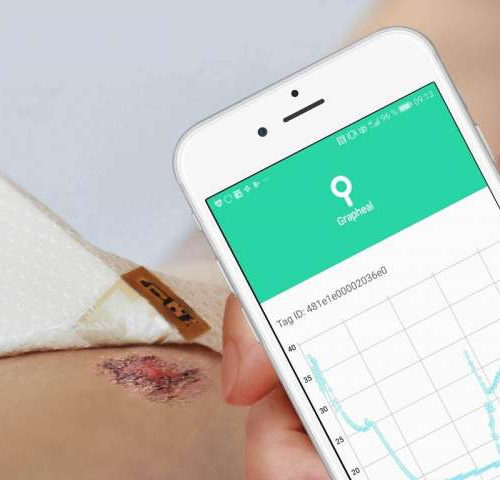BY DAN ROBITZSKI Using graphene, a nanomaterial made of carbon that’s just one atom thick, scientists say they’ve made a cheap, more accessible antibody test for kidney disease. The goal, the University of Manchester researchers say in a press release, was to make a test that measures specific antibodies quickly at the doctor’s office, rather than in whatever...
Tag: <span>Graphene</span>
Graphene for remote wound monitoring
by Plataforma SINC French scientists at the Neel Institute have produced a graphene patch that records the condition of chronic wounds, such as ulcers suffered by the elderly or those with diabetes, at any time. The data can be sent from home to the hospital via mobile phone, facilitating a rapid response to possible infections....
Flexible Vitals Sensors Made from Graphene Sensitized with Quantum Dots
MEDGADGET EDITORSCARDIOLOGY, DIAGNOSTICS, MATERIALS, MEDICINE, SPORTS MEDICINE At the ICFO – The Institute of Photonic Sciences, in Catalonia, Spain, researchers have come up with a way to use graphene to make flexible photodetectors to measure heart rate, blood oxygen concentration, and breathing rate. Additionally, the technology can also be used to measure UV levels coming...
MIT punches out cell-sized robots made of graphene
MIT researchers have developed a technique to mass produce cell–sized robots out of graphene(Credit: Felice Frankel) Robots are getting smaller and smaller, from the size of bugs down to tiny bead-shaped robots that could one day swim through the body to monitor health or deliver medication. MIT engineers recently managed to create cell–sized robots that could collect data about their environment, but were a little tricky to manufacture. Now, the team has found...
Zap! Graphene is bad news for bacteria
Rice, Ben-Gurion universities show laser-induced graphene kills bacteria, resists biofouling HOUSTON – (May 22, 2017) – Scientists at Rice University and Ben-Gurion University of the Negev (BGU) have discovered that laser-induced graphene (LIG) is a highly effective anti-fouling material and, when electrified, bacteria zapper. LIG is a spongy version of graphene, the single-atom layer of carbon atoms. The Rice...
Graphene, electricity used to change stem cells for nerve regrowth
Summary: Scientists are combining their expertise to change stem cells for nerve regrowth. Researchers trying to regenerate nerve cells might face a hard time. For example: Schwann cells. They form sheaths around axons, the tail-like part of nerve cells that carry electrical impulses. They promote regeneration of those axons. And they secrete substances that promote...
First use of graphene to detect cancer cells
What can’t graphene do? You can scratch “detect cancer” off of that list. By interfacing brain cells onto graphene, researchers at the University of Illinois at Chicago have shown they can differentiate a single hyperactive cancerous cell from a normal cell, pointing the way to developing a simple, noninvasive tool for early cancer diagnosis. “This graphene system...

